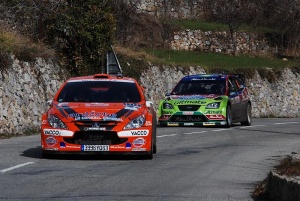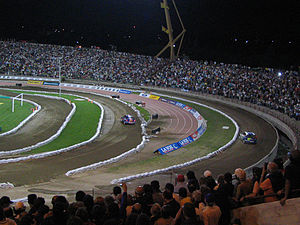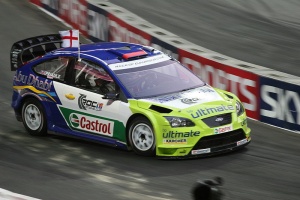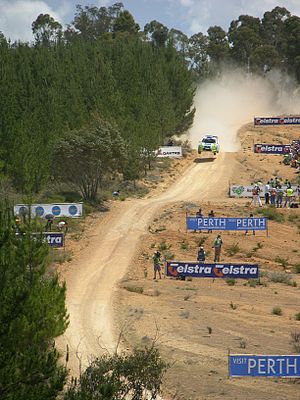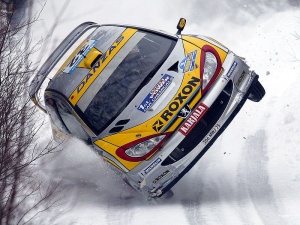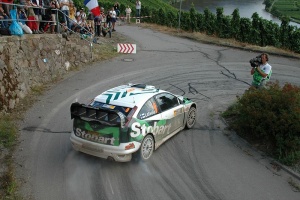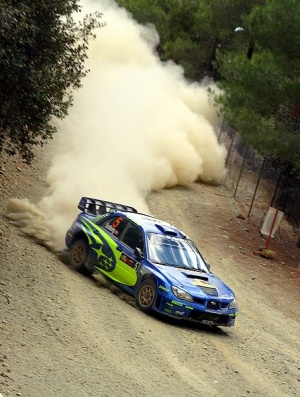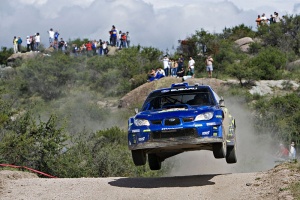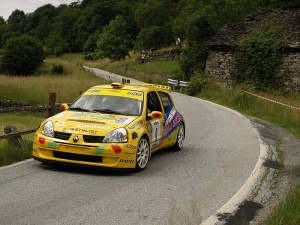World Rally Championship
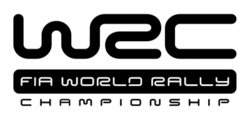
| |
| World Rally Championship | |
|---|---|
| Current season | 2009 World Rally Championship season |
| Category | World Rally Car |
| Country/region | International |
| Inaugural2 | 1973 |
| Drivers | 12 (manufacturer teams) |
| Teams | 5 (manufacturer teams) |
| Tires | |
| Champion driver | |
| Manufacturer | |
| Website | wrc.com |
The World Rally Championship (WRC) is a rallying series organised by the FIA, culminating with a champion driver, co-driver and manufacturer. The driver's world championship and manufacturer's world championship are separate championships, but based on the same point system. The series currently consists of 12 three-day events driven on surfaces ranging from gravel and tarmac to snow and ice. Each rally is split into 15-25 special stages which are run against the clock on closed roads. The sport's commercial rights are administered by International Sportsworld Communicators, who also produce the daily event highlights shown in 186 countries.
The WRC was formed from well-known and popular international rallies, most of which had previously been part of the European Rally Championship and/or the International Championship for Manufacturers, and the series was first contested in 1973. The World Rally Car is the current car specification in the series. It evolved from Group A cars which replaced the banned Group B supercars. World Rally Cars are built on production two-litre four-cylinder cars, but feature turbochargers, anti-lag systems, four-wheel-drive, sequential gearboxes, aerodynamic parts and other enhancements bringing the price of a WRC car to around US$1 million (€700,000).
The WRC features two support championships, the Junior World Rally Championship (JWRC) and the Production World Rally Championship (PWRC), which are contested on the same events and stages as the WRC, but with different regulations. The production car and junior entrants race through the stages after the WRC drivers.
History
Early

The World Rally Championship was formed from well-known international rallies, nine of which were previously part of the International Championship for Manufacturers (IMC), which was contested from 1970 to 1972. The 1973 World Rally Championship season was the inaugural season of the WRC and began with the 42ème Rallye Automobile de Monte-Carlo on January 19.
Alpine-Renault won the first manufacturer's world championship with its Alpine A110, after which Lancia took the title three years in a row with the Ferrari V6-powered Lancia Stratos, the first car designed and manufactured specifically for rallying. The first drivers' world championship was not awarded until 1979, although 1977 and 1978 seasons included an FIA Cup for Drivers, won by Italy's Sandro Munari and Finland's Markku Alén respectively. Sweden's Björn Waldegård became the first official world champion, edging out Finland's Hannu Mikkola by one point. Fiat took the manufacters' title with the Fiat 131 Abarth in 1977, 1978 and 1980, Ford with its Escort RS1800 in 1979 and Talbot with its Sunbeam Lotus in 1981. Waldegård was followed by German Walter Röhrl and Finn Ari Vatanen as drivers' world champions.
Group B era
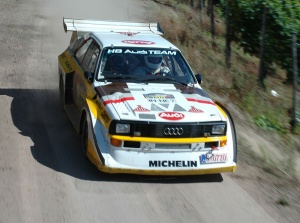
The 1980s saw the rear-wheel-drive Group 2 and the more popular Group 4 cars be replaced by more powerful four-wheel-drive Group B cars. FISA legalized all-wheel-drive in 1979, but most manufacturers believed it was too complex to be successful. However, after Audi started entering Mikkola and the new four-wheel-drive Quattro in rallies for testing purposes with immediate success, other manufacturers started their all-wheel-drive projects. Group B regulations were introduced in the 1982 season, and with only a few restrictions allowed almost unlimited power. Audi took the constructors' title in 1982 and 1984 and drivers' title in 1983 (Mikkola) and 1984 (Stig Blomqvist). Audi's French female driver Michèle Mouton came close to winning the title in 1982, but had to settle for second place after Opel rival Röhrl. 1985 title seemed set to go to Vatanen and his Peugeot 205 T16 but a bad accident at the Rally Argentina left him to watch compatriot and team-mate Timo Salonen take the title instead. Italian Attilio Bettega had even a more severe crash with his Lancia 037 at the Tour de Corse and died instantly.
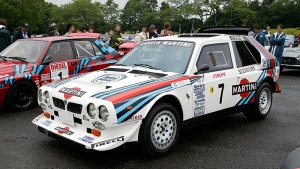
The 1986 season started with impressive performances by Finns Henri Toivonen and Alén in Lancia's new turbo- and supercharged Delta S4, which could reportedly accelerate from 0-60 mph (96 km/h) in 2.3 seconds, on a gravel road. However, the season soon took a dramatic turn. At the Rally Portugal, three spectators were killed and over 30 injured after Joaquim Santos lost control of his Ford RS200. At the Tour de Corse, championship favourite Toivonen and his co-driver Sergio Cresto died in a fireball accident after plunging down a cliff. Only hours after the crash, Jean-Marie Balestre and the FISA decided to freeze the development of the Group B cars and ban them from competing in 1987. More controversy followed when Peugeot's Juha Kankkunen won the title after FIA annulled the results of the San Remo Rally, taking the title from fellow Finn Alén.
Group A era
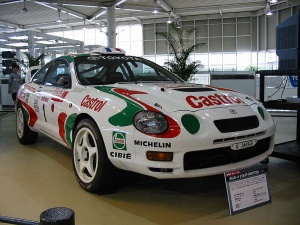
As the planned Group S was also cancelled, Group A regulations became the standard in the WRC until 1997. A separate Group A championship had been organized as part of the WRC already in 1986, with Sweden's Kenneth Eriksson taking the title with a Volkswagen Golf GTI 16V. Lancia was quickest in adapting to the new regulations and controlled the world rally scene with Lancia Delta Integrale, winning the constructors' title six years in a row from 1987 to 1992. Kankkunen and Miki Biasion both took two drivers' titles with the Integrale.
The 1990s then saw the Japanese manufacturers, Toyota, Subaru and Mitsubishi, become title favourites. Spain's Carlos Sainz driving for Toyota Team Europe took the 1990 and 1992 titles with a Toyota Celica GT-Four. Kankkunen moved to Toyota for the 1993 season and won his record fourth title, with Toyota taking its first manufacturers' crown. Frenchman Didier Auriol brought the team further success in 1994, and soon Subaru and Mitsubishi continued the success of the Japanese constructors. Subaru's Scotsman Colin McRae won the drivers' world championship in 1995 and Subaru took the manufacturers' title three years in a row. Finland's Tommi Mäkinen driving a Mitsubishi Lancer Evolution won the drivers' championship four times in a row, from 1996 to 1999. Mitsubishi also won the manufacturers' title in 1998.
World Rally Car era
For the 1997 season, the World Rally Car regulations were introduced as an intended replacement for Group A (only successive works Mitsubishis still conforming to the latter formula; until they, too, homologated a Lancer Evolution WRC from the 2001 San Remo Rally). After the success of Mäkinen and the Japanese manufacturers, France's Peugeot made a very successful return to the World Rally Championship. Finn Marcus Grönholm took the drivers' title in his first full year in the series and Peugeot won the manufacturers' crown. England's Richard Burns won the 2001 title with a Subaru Impreza WRC, but Grönholm and Peugeot took back both titles in the 2002 season. 2003 saw Norway's Petter Solberg become drivers' champion for Subaru and Citroën continue the success of the French manufacturers. Citroën's Sébastien Loeb went on to control the following seasons with his Citroën Xsara WRC. Citroën took the constructors' title three times in a row and Loeb surpassed Mäkinen's record of four drivers' titles earning his fifth with the 2008 season win. After many titleless years at the top with their Ford Focus WRC, Ford took the 2006 and 2007 manufacturers' titles with drivers Marcus Grönholm and Mikko Hirvonen.
Structure
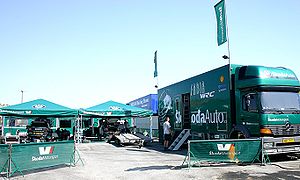
Each season normally consists of 13 rallies driven on surfaces ranging from gravel and tarmac to snow and ice. Points from these events are calculated towards the drivers' and manufacturers' world championships. The driver's championship and manufacturer's championship are separate championships, but based on the same point system. This means, for example, that Petter Solberg driving for Subaru can win the driver's championship but Citroën can win the manufacturer's championship, which is what happened in 2003, and again in 2006 and 2007 when Sébastien Loeb took his third and fourth WRC titles but Ford won the manufacturer's championship. In the current points system, points are awarded at the end of each rally to the top eight WRC (overall), junior and production car drivers that qualify as follows: 10, 8, 6, 5, 4, 3, 2, 1. Despite how many drivers are in one team, constructors can only nominate two drivers to score points for the team as well as scoring for themselves. As only nominated drivers are counted while awarding points, even competitors placed further down than eighth overall (if preceded by privateer drivers) can score them.
In the current era, each rally usually consists of 15-35 special stages of distances ranging from under 2 km (1.24 mi) (super specials) to over 50 km (31 mi). These competitive stages driven on closed roads are linked by non-competitive road sections which are on open roads on which all road laws of that country must be adhered to. On average a day consists of a total of Template:Km to mi of driving. A WRC event begins with reconnaissance (recce) on Tuesday and Wednesday, allowing crews to drive through the stages and create or update their pacenotes. On Thursday, teams can run through the shakedown stage to practice and test their set-ups. The competition begins on Friday and ends on Sunday. Cars start the stages at one or two minute intervals. Each day, or leg, has a few designated service parks between the stages, where the teams can – within strict time limits – perform maintenance and repairs on their cars. The service park also allows spectators and the media to get close to the teams and their cars and drivers. Between the days, after a 45-minute end of day service, cars are locked away in the guarded parc fermé.
Cars
The production-based 2.0 L turbocharged four-wheel drive cars are built to World Rally Car regulations racing across tarmac, gravel and snow. The power output has been limited to around 300 bhp (225 kW). Current cars in the championship include the Citroën C4 and Ford Focus RS. Citroën, Peugeot, Škoda and Mitsubishi pulled out of the championship for 2006 and those cars, although in use by privateers, are not in further development. Citroën returned to WRC in 2007 using the C4. The Suzuki World Rally Team joined the 2008 championship for the first time with their SX4 but they have pulled out of the 2009 championship together with Subaru because of the economic downturn currently affecting the automotive industry.
The WRC was formerly held for Group A and Group B rallycars. However, due to the increasing power, lack of reliability and the fatal accidents on the 1986 season, Group B was permanently banned. Later, in 1997, the Group A cars evolved into the WRC car spec, to ease the development of new cars and bring new makes to the competition.
Cars in the Production car World Rally Championship are limited to production-based cars homologated under Group N or Super 2000 rules. Most cars in the Junior World Rally Championship are homologated under Super 1600 rules, but Group N and selected Group A cars can also contest the series.
Teams and drivers
- See 2010 WRC season for a list of the teams and drivers.
20 different manufacturers have won a World Rally Championship event, and a further ten have finished on the podium.
For The 2009 season, the championship has two manufacturer teams (Citroën Total World Rally Team and BP Ford Abu Dhabi World Rally Team) and three semi-factory teams (Stobart VK M-Sport Ford, Munchi's Ford and the Citroën Junior Team) that will be eligible for the manufacturers' championship.
Suzuki and Subaru pulled out of the WRC at the end of the 2008 championship, both citing the economic downturn currently affecting the automotive industry for their withdrawal.
A typical WRC team will consist of about 40 people on the events, with a further 60-100 at the team base.
Manufacturers and manufacturer-backed teams usually have two or three drivers participating in each rally and eligible to score points. The total number of crews (driver and his co-driver) in the rallies varied from 47 (Monte Carlo and Mexico) to 108 (Great Britain) during the 2007 season.
2010 Calendar
- See 2010 WRC season
| Round | Dates | Rally Name | Rally HQ | Support Category | Surface |
|---|---|---|---|---|---|
| 01 | 14 February | Swedish Rally | PWRC/WRC Cup | Ice and snow covered gravel | |
| 02 | 07 March | Rally Mexico | PWRC/WRC Cup | Gravel | |
| 03 | 04 April | Jordan Rally | PWRC/WRC Cup | Gravel | |
| 04 | 18 April | Rally Turkey | JWRC | Gravel | |
| 05 | 09 May | Rally New Zealand | PWRC/WRC Cup | Gravel and Asphalt | |
| 06 | 30 May | Rally de Portugal | JWRC/WRC Cup | Gravel | |
| 07 | 10 July (Saturday finish) | Rally Bulgaria | JWRC | Asphalt | |
| 08 | 01 August | Rally Finland | PWRC/WRC Cup | Gravel | |
| 09 | 22 August | Rallye Deutschland | JWRC/PWRC/WRC Cup | Asphalt | |
| 10 | 12 September | Rally Japan | PWRC/WRC Cup | Gravel | |
| 11 | 03 October | Tour de Corse | JWRC/PWRC/WRC Cup | Asphalt | |
| 12 | 24 October | Rally Catalunya | JWRC | Asphalt | |
| 13 | 14 November | Wales Rally GB | PWRC/WRC Cup | Gravel |
Coverage
TV
ISC TV produce daily updates of each event after the day's stages have finished and the TV coverage has been processed. These daily highlight programs are around 30 minutes in duration and cover in depth the day's stages, with in-car footage as well as driver interviews. Before the rally there is also a Rally Preview that normally incorporates special driver, technical and team features as well as providing an overview of the upcoming rally's route. There is also a review program, which lasts approximately an hour, that summarises the rally and the big events that took place during the duration; the stages are not in such detail as the daily updates as it is a review program.
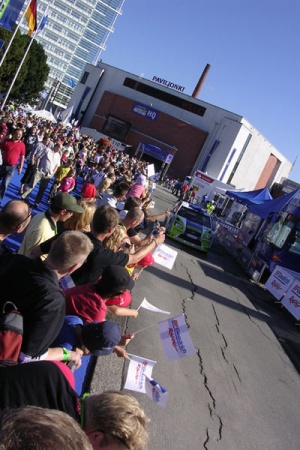
This is then shown in 186 different countries in multiple languages, each day of the event. The make up and format for the telecast can change from country to country depending on the local broadcaster but it all uses ISC TV feeds. ISC TV also provides coverage of all of the events in the Junior World Rally Championship and the Production World Rally Championship in a 26-minute highlights package.
Also produced after each event is the lifestyle entertainment programme called WRC All Access, focused on a behind the scenes experience of WRC life, both on and off the road. These programmes focus on all elements of each country visited including culture, food, people, attractions as well as the WRC event itself. Rally World, a weekly rally programme reviews events from all around the planet, including the WRC, the PWRC, the JWRC as well as Asia Pacific Rally Championship, the Australian Rally Championship and the Middle East Rally Championship among others.
In the United Kingdom, coverage of the three-day event is shown on Dave on Sundays after the event is completed. Dave also shows different programmes on rallying – for example about WRC cars or crashes – before showing coverage of the event.
During the 2007 season, the cumulative worldwide TV audience for ISC's WRC programming was 816 million. The programming was available in over 180 countries, and was broadcast on over 250 different TV channels. The total number of dedicated broadcasts was 12,445, and the total number of hours of coverage was 5,457.
Radio
Live radio coverage is provided in English by World Rally Radio via the Internet, featuring end of stage reports direct from the drivers and teams plus service park news. It also features contemporary music during breaks in rally coverage. This coverage can even simulcast on local radio or via a temporary licence, pending on the event and its organisers. They are also responsible for producing podcasts for each day of each event available for download.
Champions
Records
| Driver championships | Driver rally wins | Manufacturer championships | Manufacturer rally wins | |||||||||||
|---|---|---|---|---|---|---|---|---|---|---|---|---|---|---|
| Place | Driver | Titles | Place | Driver | Wins | Place | Manufacturer | Titles | Place | Manufacturer | Wins | |||
| 1 | 6 | 1 | 54 | 1 | 10 | 1 | 73 | |||||||
| 2 | 4 | 2 | 30 | 2 | 5 | 73 | ||||||||
| 4 | 3 | 26 | 5 | 3 | 60 | |||||||||
| 4 | 2 | 4 | 25 | 4 | 3 | 4 | 48 | |||||||
| 2 | 5 | 24 | 3 | 5 | 47 | |||||||||
| 2 | 6 | 23 | 3 | 6 | 43 | |||||||||
| 2 | 7 | 20 | 3 | 7 | 34 | |||||||||
| 8 | 11 drivers are tied with a single championship each. | 20 | 8 | 2 | 8 | 24 | ||||||||
| 9 | 18 | 9 | 3 manufacturers tied with a single championship each | 9 | 21 | |||||||||
| 10 | 17 | 10 | 9 | |||||||||||
- Note: bold text indicates active drivers and teams.
Other classes
The World Rally Championship also features support championships called the Production car World Rally Championship (PWRC) and the Junior World Rally Championship (JWRC). These championships are contested on the same events and stages as the WRC. In 2008, The PWRC includes eight and the JWRC seven events. In 2007, the junior championship had no events outside Europe so it was known simply as the Junior Rally Championship (JRC).
The Production car World Rally Championship began in 2002, replacing the FIA Group N Cup which had been contested from 1987. Cars in the championship are production-based and homologated under Group N or Super 2000 rules. The Junior World Rally Championship was started in 2001, and can be contested with Super 1600, Group N and selected Group A cars. Drivers in the championship have to be 28 years or younger. There is no age limit for co-drivers.
Video games
There have been many video games based on the World Rally Championship, and due to lack of licenses, many more based on only certain cars, drivers or events. Sega Rally was released in 1995, V-Rally and Top Gear Rally in 1997 and the first game in the very popular Colin McRae Rally series in 1998. Rally Trophy, released in 2001 for Microsoft Windows by Bugbear, concentrated on historic cars such as Alpine A110 and Lancia Stratos. RalliSport Challenge, released in 2002 for Windows and Xbox by Digital Illusions CE, featured classic Group B cars and hillclimb models along with modern WRC cars.
Fully FIA licensed WRC: World Rally Championship was released in 2001 for PlayStation 2 by Evolution Studios. The video game series had its fifth game, WRC: Rally Evolved, in 2005. Racing simulator Richard Burns Rally, released in 2004 for several platforms, has gathered recognition for its realism. Recent top-selling games include Colin McRae: Dirt and Sega Rally Revo. Gran Turismo 5 will include the WRC totally licensed.
External links
- News and information
- Results
- RallyBase.nl — result database;
- eWRC-results.com — complex and up-to-date results database; Template:Cs icon
- juwra.com - World Rally Archive — database and statistics;
Template:World Rally Championship results Template:Main world championships
